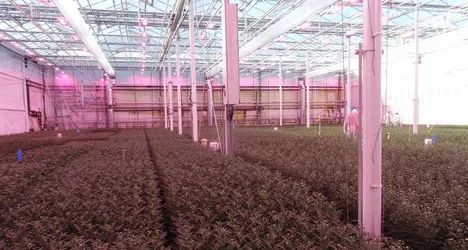Compared to SON-T, LED lighting saves a lot of energy in the cultivation of chrysanthemums. But with LED the chrysanthemum remains too compact in the first period of development. Far-red light at the beginning of the dark period can provide a solution and also has the positive effect that the lower leaves yellow less quickly.
The perfect chrysanthemum
The project 'Chrysanthemum under 210 µmol/m2/s energy-efficient LED' is better known as 'The Perfect Chrysanthemum'. WUR is collaborating with Delphy on this. Two chrysanthemum varieties are grown in a department of Delphy-Improvement Center, along with 12 other varieties on a smaller scale. WUR is responsible for project management, crop and climate measurements and the analysis of the measurement results.

A perfect chrysanthemum is a chrysanthemum with a good weight-to-length ratio that has a long shelf life and can withstand transport. In cultivation, the light is efficiently converted into production. Under LED (RWB 88/6/6%) the stems of a number of varieties remain too short in the season the plants receives the most light from LED. The lower leaves are close together and therefore the moisture balance around the leaf is probably not optimal and there is a risk of leaf yellowing.
Further development and application
Adding far red light (far red, FR) seems to be a solution for this. The crop receives 20 µmol/m2/s far-red light in the first half hour of the dark period. Research by WUR showed that far red leads to more stretching. A second effect is that the development of side shoots is reduced. This can be positive if unwanted shoots remain at the bottom of the crop, but negative if too few flowers develop. In the coming period, WUR will conduct further research into the application of far-red light. The results are then applied again in the ongoing study 'The Perfect Chrysanthemum'.
This project was financed from the Kas als Energiebron program, the innovation and action program of the Ministry of Agriculture, Nature and Food Quality and Greenhouse Horticulture Netherlands, chrysanthemum growers, Ludvig Svensson, Signify, Dummen Orange, Royal van Zanten, Floritec and Koppert biological systems.
 For more information:
For more information:
Wageningen University & Research
www.wur.nl
